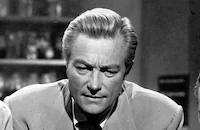The Gracie Allen Murder Case
Brief Synopsis
Cast & Crew
Alfred E. Green
Gracie Allen
Warren William
Ellen Drew
Kent Taylor
Jed Prouty
Film Details
Technical Specs

Synopsis
Bill Brown tries to make his girl friend, Ann Wilson, jealous by flirting with Gracie Allen, the niece of his boss, at a company picnic. Quickly irritated by Gracie's relentless illogic, Bill nevertheless escorts her to the Diamond Slipper Cafe, where Gracie discovers Bill's cigarette case next to the body of escaped convict Benny "The Buzzard" Nelson. Gracie blithely incriminates Bill during the police investigation, and a worried Ann brings detective Philo Vance on to the case. During the course of the investigation, which is hampered by Gracie's maddening interference, Dixie Del Marr, a dancer at the Diamond Slipper, is murdered by poison placed on flowers that Vance had sent her. Quickly exonerated, Vance deduces that the killer is Daniel Mirche, the owner of the Diamond Slipper, who had framed the Buzzard for crimes committed by himself. Confronted by Vance and the police, Mirche implicates his lawyer, Richard Lawrence, in the murders and is about to shoot Vance when Gracie arrives, turning the tables on Mirche by providing evidence against Lawrence and preventing Vance from smoking a poisoned cigarette that he has been unknowingly carrying. The murders solved, Ann and Bill are reunited.

Director
Alfred E. Green
Cast

Gracie Allen

Warren William

Ellen Drew

Kent Taylor
Jed Prouty

Jerome Cowan

Donald Macbride

H. B. Warner

William Demarest
Judith Barrett
Horace Macmahon
Al Shaw
Sam Lee
Walter Soderling
Lee Moore
Harry Tyler

James Flavin
Willie Fung
Jack Baxley
Don Brodie
Rube Demarest
Lillian Yarbo
James Kelso
Helen Mackellar
Edgar Dearing
Esther Howard
Janet Waldo
William Haade
George Hickman
Billy Daniels
Ben Taggart
Philip Morris
James B. Carson
Sue Moore

Addison Richards
Max Wagner
Dutch Hendrian
Mike Tellegen
Paul "tiny" Newlan
Monty Collins

Richard Denning
Philip Warren

Irving Bacon
Henry Roquemore
Norman Phillips Jr.
Ted Oliver
Frank Meredith
Florence Wix
Major Sam Harris
Crew
George Arthur
Hans Dreier
A. E. Freudeman
Edith Head
Earl Hedrick
Don Johnson
Charles Lang Jr.
William Lebaron
Frank Loesser
Matty Malneck
Russell Mathews
Gene Merritt
Nat Perrin
Paul Weatherwax

Film Details
Technical Specs

Articles
Ellen Drew, 1914-2003
She was born Esther Loretta "Terry" Ray on November 23, 1914, in Kansas City, Missouri. The daughter of a barber, her family moved to Chicago when she was still an infant and she lived a very quiet childhood far removed from the glamour of Hollywood. She was encouraged by some friends to enter a beauty contest when she was just 17. After winning, she tried her luck in Hollywood, but found that they were no immediate offers for her particular talents.
She eventually took a waitressing job at C.C. Brown's, a famed Hollywood Boulevard soda fountain, and had virtually abandoned her dreams as a starlet when William Demarest, a popular actor's agent and well-known character actor, spotted her. Demarest arranged a screen test for her at Paramount, and she was promptly placed under contract for $50 a week.
For the first few years, (1936-38), Drew got only bit parts, and was often uncredited. When she finally got prominent billing in the Bing Crosby musical Sing You Sinners (1938), she decided to change her name, from Terry Ray to Ellen Drew. She earned her first major role in Frank Lloyd's If I Were King (1938) opposite Ronald Colman, yet for the most part of her career, rarely rose above "B" material and second leads. Still, she had some fine exceptions: Preston Sturges' enchanting comedy Christmas in July (1940), with Dick Powell; Tay Garnett's lighthearted war romp My Favorite Spy (1942) co-starring Kay Kyser; Julien Duvivier's taut The Imposter (1944), holding her own with a brooding Jean Gabin; and Mark Robson's chilling low-budget chiller Isle of the Dead (1945) opposite Boris Karloff. Drew made some notable television appearances in the late '50s including Perry Mason and The Barbara Stanwyck Show, before retiring from the entertainment industry. She is survived by her son David; five grandchildren; and five great-grandchildren.
by Michael T. Toole

Ellen Drew, 1914-2003
Quotes
Trivia
Notes
This was Gracie Allen's first picture without George Burns. For information on other films featuring the "Philo Vance" character, for The Kennel Murder Case and consult the Series Index.














